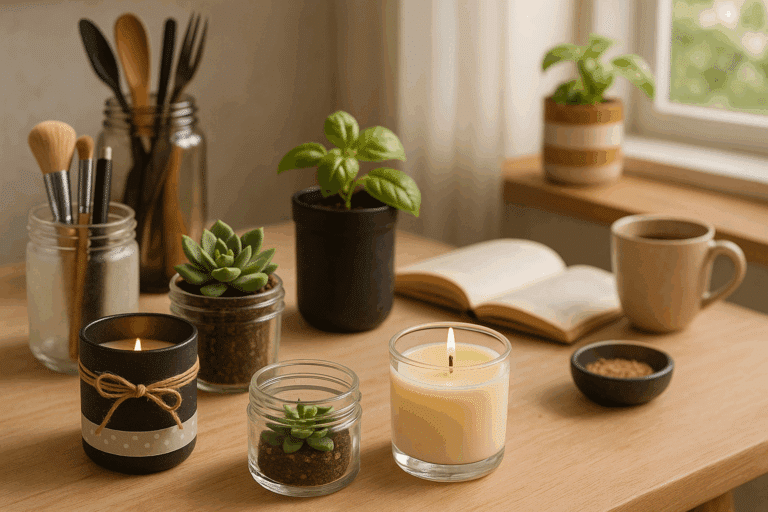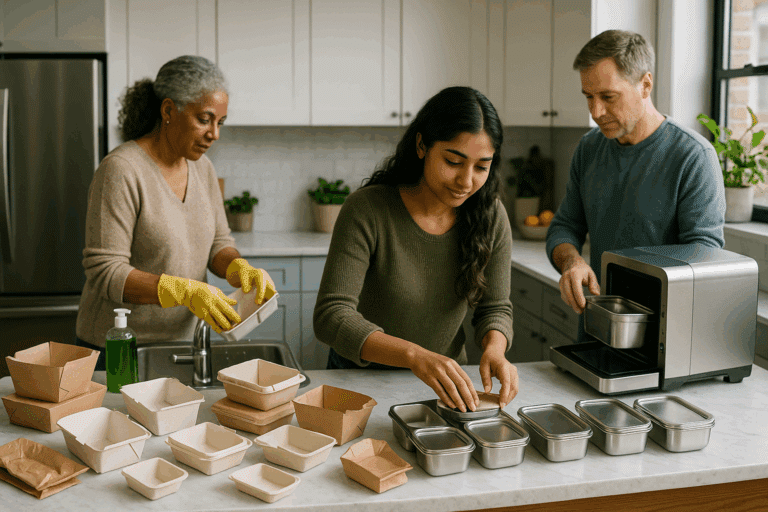How many cardboard boxes do you see? In a world where e-commerce has taken a giant leap forward, cardboard boxes have multiplied in our homes like never before. But rather than just being discarded, these humble pieces of corrugated material can be transformed into stunning and functional masterpieces. Let’s take a closer look at how this transformation can happen. 📦🔄🎨
In this blog post, we are going to dive into the fascinating world of cardboard transformation. We will explore various innovative and creative ways to repurpose these seemingly mundane boxes into stylish and functional masterpieces. From aesthetically pleasing home decor to useful organizational tools, the possibilities are virtually endless when you start to think outside the box. 😉
Cardboard is a material that lends itself well to creativity. It’s a blank canvas that can be molded, shaped, and decorated to fit a variety of different functions and styles. From a practical standpoint, it’s durable, readily available, and eco-friendly. Plus, it’s a cost-effective way to create unique and personalized items for your home or office.
By the end of this article, we hope to inspire you to see cardboard in a new light. Not just as a simple shipping vessel, but as a valuable resource that can be repurposed into something beautiful and useful. Whether you’re an amateur DIY enthusiast or a seasoned professional, there’s something here for everyone. 🏡💼
So, what can you expect to learn in this comprehensive guide? We’ll start by providing a bit of background on the versatility of cardboard. We’ll delve into its origins, its composition, and how its unique properties make it a perfect material for crafting.
Next, we’ll discuss some simple yet effective techniques for working with cardboard. These include cutting, bending, and joining pieces together, as well as different ways to finish and decorate your cardboard creations. These tips and tricks will provide you with the foundation you need to start your own cardboard crafting journey. ✂️🖌️
Finally, we’ll showcase a range of inspiring examples of what can be achieved when you start to rethink and reinvent cardboard. From stylish furniture pieces to functional storage solutions, we’ll provide step-by-step instructions for a selection of unique cardboard creations. 🪑📦
Before we get started, it’s important to remember that transforming cardboard into something beautiful isn’t just about crafting for the sake of crafting. It’s about finding sustainable solutions in a world that’s increasingly aware of the impact we’re having on our environment. By repurposing cardboard, we’re not only creating something useful and beautiful; we’re also contributing to a greener and more sustainable future. 🌍🌱
So, are you ready to challenge your perceptions of cardboard and unleash your creativity? Prepare to be amazed as we explore the endless possibilities of transforming boxes into stylish and functional masterpieces. Let’s get started! 💡🚀
📦 Unpacking the Potential of Cardboard: An Artistic and Functional Revolution
Cardboard is more than just a medium for packaging. It’s a recyclable, sustainable, and versatile material that, with a bit of creativity, can be transformed into stylish and functional masterpieces. This article dives deep into the innovative world of cardboard reinvention and explores how ordinary boxes can become extraordinary creations.
In a world where sustainability is becoming increasingly important, the use of cardboard offers numerous benefits. It’s widely available, cost-effective, and can easily be manipulated into a variety of forms. But its potential is often overlooked, seen merely as a carrier of goods rather than a material with creative promise.
From furniture design to architectural structures, from intricate sculptures to playful toys, cardboard can be the star of the show. So, let’s take a journey through this cardboard revolution, highlighting the innovative ways that boxes are being transformed into stylish and functional masterpieces. But first, let’s look at why cardboard is such a promising material.
♻️ The Sustainability of Cardboard: A Material for the Future
Cardboard is a recyclable and biodegradable material, making it an environmentally friendly alternative to many other materials. According to the American Forest & Paper Association, more than 90% of all products shipped in the US are packaged in corrugated boxes, which are then recycled at a rate of about 96%. This high recyclability rate helps to conserve resources and reduce the amount of waste that ends up in landfills.
Moreover, the process of recycling cardboard is energy-efficient. According to the Environmental Protection Agency (EPA), recycling cardboard saves 24% of the total energy needed for virgin cardboard. And in terms of CO2 emissions, producing recycled cardboard emits 25% less CO2 than producing new cardboard.
But sustainability is not the only asset of cardboard. Its flexibility and strength make it an excellent material for creating a wide range of items. So, let’s see how cardboard is reinventing the way we create.
🏠 Cardboard in Architecture and Furniture Design
Cardboard is gaining momentum in the world of architecture and furniture design. Its strength, flexibility, and affordability make it a viable option for creating sustainable and innovative structures and furnishings.
In architecture, the use of cardboard allows for experimental and eco-friendly designs. The renowned Japanese architect, Shigeru Ban, is a pioneer in using cardboard tubes to create temporary structures like churches, concert halls, and homes. His Cardboard Cathedral in Christchurch, New Zealand, is a testament to the potential of cardboard in architecture.
Similarly, in furniture design, cardboard offers a sustainable and cost-effective alternative to traditional materials. Many designers are now creating cardboard furniture that is not only functional and affordable, but also aesthetically pleasing. From chairs and tables to bookshelves and lamps, these pieces showcase the versatility and potential of cardboard.
📺 Video: “Cardboard Furniture – DIY Room Decorating Ideas for Teenagers” (DIY Craft Projects, YouTube)
To get a glimpse of how cardboard can be used in furniture design, check out this YouTube video titled “Cardboard Furniture – DIY Room Decorating Ideas for Teenagers” by DIY Craft Projects. The video demonstrates how to make a stylish and functional desk out of cardboard, providing a step-by-step guide to the process. You’ll be amazed at the results!
🎨 Cardboard in Art and Sculpture
Cardboard is not just limited to practical applications; it also has a place in the world of art and sculpture. Artists across the globe are using cardboard to create stunning and thought-provoking pieces.
For instance, Australian artist Daniel Agdag creates intricate, surrealistic sculptures entirely out of cardboard. His meticulously crafted pieces explore themes of machinery, industry, and urbanism. Similarly, UK artist James Lake uses cardboard to create life-sized sculptures, bringing a new dimension to the medium.
Cardboard art is also a great way for children and adults alike to express their creativity. From cardboard collages to three-dimensional sculptures, the possibilities are endless. So, why not give it a try?
📺 Video: “The Art of Cardboard Sculpture with James Lake” (Tate, YouTube)
For some inspiration, watch this YouTube video titled “The Art of Cardboard Sculpture with James Lake” by Tate. In the video, Lake shares his process and talks about how working with cardboard has helped him express his creativity. It’s truly inspiring to see what can be achieved with this humble material.
💡 Creative Ideas for Reinventing Cardboard Boxes
By now, you’re probably excited about the endless possibilities of cardboard. But where should you start? Here are some creative ideas for reinventing cardboard boxes into stylish and functional masterpieces:
- Furniture: Create your own cardboard furniture, like chairs, tables, or bookshelves. Not only is it cost-effective, but it’s also a fun and creative way to decorate your home or office.
- Art and Sculpture: Use cardboard to create stunning pieces of art or sculpture. Let your imagination run wild and see what you can create.
- Toys: Cardboard can be used to make a variety of toys, from dollhouses to cars. It’s a great way to engage children in creative play.
- Home Decor: Use cardboard to make stylish home decor items, like picture frames, wall art, or even chandeliers.
Remember, the only limit is your imagination. So, start collecting those cardboard boxes and see what you can create!

Conclusion
In conclusion, it’s vital to revisit and grasp the key points discussed throughout this comprehensive piece. As we dove deep into the intricate world of Information Technology and Engineering, we shed light on some complex concepts, demystifying them in a manner that’s both engaging and comprehensible.
We kicked off by exploring the critical role of software engineering in today’s fast-paced digital age 🚀. It’s clear that software engineering is not just about coding but extends to understanding and solving real-world problems with technology. Our detailed analysis of the various stages of the software development lifecycle—from requirements gathering to design, implementation, testing, and maintenance—highlights the diverse skill set required in this field.
We further delved into the significance of effective technical writing in these sectors. A potent tool in the hands of IT and engineering professionals, technical writing simplifies complex information, thereby facilitating better understanding and decision-making. We touched upon the essential aspects of this craft—from clarity, precision, and coherence to the use of visuals, all of which ensure that the intended message is delivered as effectively as possible 👌.
Moreover, we ventured into the world of artificial intelligence and machine learning, presenting a panoramic view of these breakthrough technologies. In the process, we underscored their transformative potential, and their capacity to drive the next wave of technological innovation 🌊.
So, what does this all mean for you?
Whether you’re a budding software engineer, an experienced IT professional, or simply a technology enthusiast, this in-depth exploration equips you with a nuanced understanding of these topics. And this understanding, in turn, empowers you to navigate the technological landscape more efficiently and make more informed decisions.
I encourage you to reflect upon what you’ve learned here and consider how you might apply this knowledge in your own journey. Whether it’s adopting more effective technical writing practices or exploring the potential of AI and machine learning, there’s no better time than now to take that first step 👣.
Your feedback is invaluable, so don’t hesitate to share your thoughts, queries, or experiences in the comments below. If you found this article insightful, do share it with your peers to spread the knowledge 💡.
For more on these topics, you may find the following resources helpful:
– [MIT OpenCourseWare: Introduction to Software Engineering](https://ocw.mit.edu/courses/electrical-engineering-and-computer-science/6-170-software-studio-spring-2013/)
– [Stanford Online: Technical Writing](https://online.stanford.edu/courses/soe-ycs0002-technical-writing)
– [Coursera: Machine Learning](https://www.coursera.org/learn/machine-learning)
And remember, as the legendary scientist Isaac Asimov once said, “The most exciting phrase to hear in science, the one that heralds new discoveries, is not ‘Eureka!’ but ‘That’s funny…'” So stay curious, keep learning, and let’s unravel the mysteries of technology together.
Until next time, happy exploring! 👋



